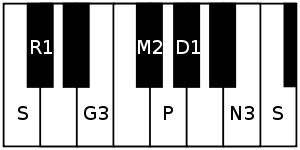Kamavardhani
Kamavardhini (pronounced kāmavardhini - காமவர்தினி / कामवर्धिनि:) is a rāgam in Carnatic music (musical scale of South Indian classical music). It is the 51st Melakarta rāgam in the 72 melakarta rāgam system of Carnatic music. It is also referred by the name Pantuvarāḷi,[1] although purists prefer to designate it as Kamavardhini. It literally means "that which increases desire".
| Arohanam | S R₁ G₃ M₂ P D₁ N₃ Ṡ |
|---|---|
| Avarohanam | Ṡ N₃ D₁ P M₂ G₃ R₁ S |
| Carnatic music |
|---|
Tanjavur-style Tambura |
| Concepts |
| Compositions |
| Instruments |
|
This rāgam is very popular with musicians who typically sing it in the beginning of a concert. It is called Kāshirāmakriya in the Muthuswami Dikshitar school. The Hindustani music equivalent of Kamavardhini is the Poorvi thaat/Puriya Dhanashree.[1][2]
Structure and Lakshana

It is the 3rd rāgam in the 9th chakra Brahma. The mnemonic name is Brahma-Go. The mnemonic phrase is sa ra gu mi pa dha nu.[1] Its ārohaṇa-avarohaṇa structure (ascending and descending scale) is as follows (see swaras in Carnatic music for details on below notation and terms):
- ārohaṇa: S R₁ G₃ M₂ P D₁ N₃ Ṡ[lower-alpha 1]
- avarohaṇa: Ṡ N₃ D₁ P M₂ G₃ R₁ S[lower-alpha 2]
(the notes in this scale are shuddha rishabham, antara gandharam, prathi madhyamam, shuddha dhaivatham, kakali nishadham)
It is a sampoorna rāgam – a rāgam that has all seven swaras (notes). This rāgam differs from the 15th melakarta rāgam Mayamalavagowla, which is the rāgam taught to a beginner in Carnatic music, only by the madhyamam. Kamavardani is the prati madhyamam equivalent of Mayamalavagowla.
Janya rāgams
It has a few minor janya rāgams (derived scales) associated with it. See List of janya rāgams for full list of rāgams associated with it.
Popular compositions
- Guruvina Gulaamanaaguva Tanaka - Purandaradasa
- Raghuvara Nannu, Shambo Mahadeva, Saramegani, Aparama bhakthi, Shobhaane, Sundara daradeham, Ninne Nera Nammi, and Shiva Shiva Shiva ena radha - Thyagaraja
- Enna ganu rama - Bhadrachala Ramadas
- Ramanatham Bajeham, Visalaksheem Visweseem,Senapathe Palayamam - Muthuswami Dikshitar,
- Ninnarul Iyambalagumo - Papanasam Sivan
- Sarasaksha Paripalaya maamayi, Paripalaya Sarasiruha and Saroruhaasana (Navarathri sixth day krithi) - Swati Tirunal
- Magalahârathide Nēku, Mahitâtma Sevite - Kalyani Varadarajan
- Inbum Niraina Paramporule (varnam)- Madurai Sri N Krishnan
- Sharanam tava - Mangalampalli Balamuralikrishna
- Shankari Ninne - Mysore Vasudevachar
Film Songs
Language: Tamil
Related rāgams
This section covers the theoretical and scientific aspect of this rāgam.
Kamavardani's notes when shifted using Graha bhedam, yields Kanakangi (the 1st melakarta). Graha bhedam is the step taken in keeping the relative note frequencies same, while shifting the shadjam to the next note in the rāgam. See further details and an illustration of Graha bhedam on Kanakangi.
Notes
- Alternate notations:
- Hindustani: S Ṟ G M̄ P Ḏ N Ṡ
- Western: C D♭ E F♯ G A♭ B C
- Alternate notations:
- Hindustani: Ṡ N Ḏ P M̄ G Ṟ S
- Western: C B A♭ G F♯ E D♭ C
References
- Ragas in Carnatic music by Dr. S. Bhagyalekshmy, Pub. 1990, CBH Publications
- Raganidhi by P. Subba Rao, Pub. 1964, The Music Academy of Madras